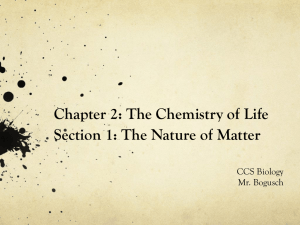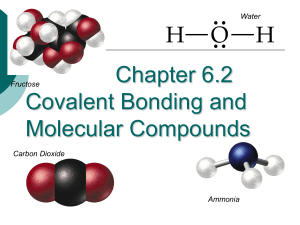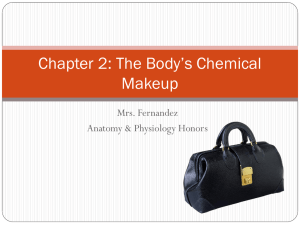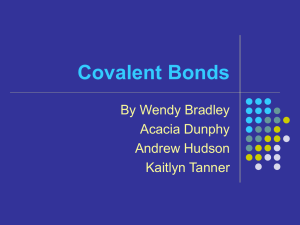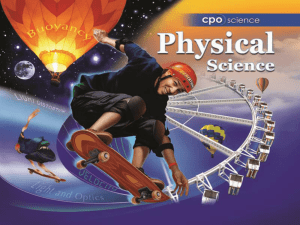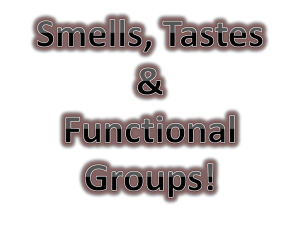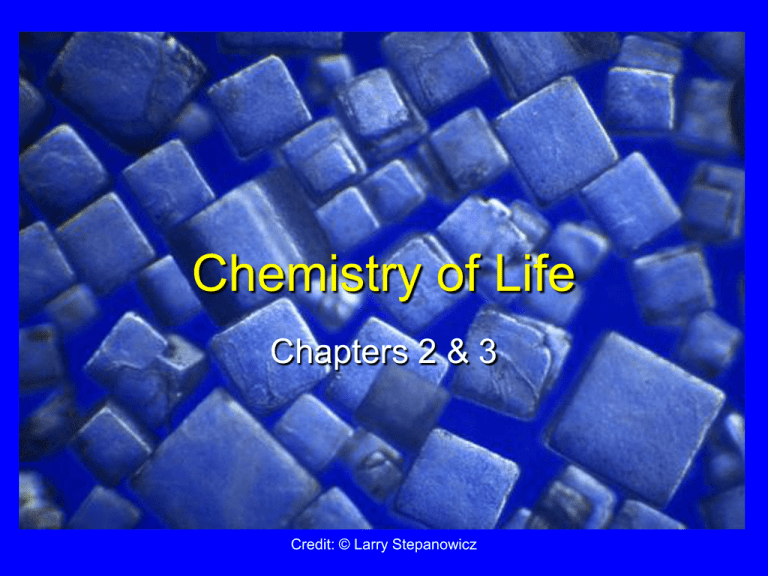
Chemistry of Life
Chapters 2 & 3
Credit: © Larry Stepanowicz
Learning Objectives
1.
2.
3.
4.
5.
6.
Differentiate between the definitions of an atom,
element, ion, and molecule.
Describe why and how atoms react chemically.
(This is a very big question!)
Differentiate between ionic bonds, covalent bonds
(polar & non-polar), and hydrogen bonds. Provide
examples.
What characteristics of water make it a good
solvent in biological systems? List all of the
characteristics we discussed in class and provide
some examples.
Discuss how and why ions are formed.
Define acid, base, and pH buffer. Provide
examples. Describe the pH scale, and the
importance of pH homeostasis.
Chemistry of Life
•
•
The chemistry of living and non-living
things obey the same “rules”
The chemistry of life has two notable
features:
1. Living things are made mostly of water
2. The large molecules of living things have
a structure based on “skeletons” of
carbon
What are these molecules called?
Elements
• The basic kinds of matter
Name some of the elements important to
living things
• Can’t be broken apart by normal
means
• 92 occur naturally on Earth
What information can you get from the
Periodic Table?
p. 20
Most Common Elements in
Living Organisms
Why is the atomic number important?
CHNOPS
All atoms of an element have the same atomic number
What is an Atom?
• Atoms are the smallest units of
matter that retain the properties
of an element
• Atoms consist of 3 types of
subatomic particles:
– protons, neutrons and electrons
• Nucleus contains protons (+) &
neutrons (neutral charge)
• Electrons (e-) surround the
nucleus as a cloud (electron
“shells” are designated regions of
the cloud)
Mass Number
Number of protons
+
Number of neutrons
Atomic nucleus
eIsotopes vary in mass number b/c the nucleus
contains a different number of
____________.
Example?
Radioisotopes
• Have an unstable nucleus that emits
energy and particles
• Radioactive decay transforms
radioisotope into a different element
• Decay occurs at a fixed rate
p. 21
Is the process of radioactive decay a chemical reaction?
Why or why not?
How is a nuclear reaction
different from a chemical
reaction?
What determines whether
atoms will interact in a
chemical reaction?
The number and arrangement
of their electrons
Molecules & Ions
p. 23
• Molecule
– when atoms share or trade electrons
– molecules make up the basic unit of a compound
– written as molecular formula showing the number
of atoms of each element (H2O, C6H12O6)
• Ions are formed by ionization
– an atom that gave up or gained an electron
– written with its chemical symbol and + or –
(Na+ , Cl-)
Electrons
Image copyright © 2003 HowStuffWorks.com
• Carry a negative charge
• Repel one another
• Are attracted to protons in
the nucleus
• Move in orbitals - volumes
of space that surround the
nucleus
• Electrons in lower orbits
have lower energy, and are
filled first
Chemical Reactions
• Atoms react chemically to form a more stable arrangement
of electrons in chemical bonds
• Bonds hold together the atoms in molecules
• An atom with a full outer electron shell is stable and unlikely
to form a bond with another atom
Name at least one atom that is non-reactive for this reason.
• Whether electrons are shared, donated or
acquired determines the type of bond formed
Chemical Bookkeeping
• Chemical equation shows reaction
Reactants ---> Products
• Equation for photosynthesis:
REACTANTS
12H2O
WATER
+
6CO2
CARBON
DIOXIDE
24 hydrogens 6 carbons
12 oxygens 12 oxygens
sunlight
energy
p. 23
PRODUCTS
6O2
+
OXYGEN
12 oxygens
C6H12O6
GLUCOSE
+
6H2O
WATER
6 carbons 12 hydrogens
12 hydrogens 6 oxygens
6 oxygens
p. 23
Electron Orbitals: The Shell Model
• Atoms react to
reach a more
stable state (e.g.
fill the outermost
orbital)
• Octet rule :
biologically
important
elements interact
to produce
chemically stable
arrangements of
8 electrons in the
outermost
occupied
electron shell.
• Max = 2n2 , where
n = shell number
SODIUM
11p+ , 11e-
CHLORINE
17p+ , 17e-
CARBON
6p+ , 6e-
OXYGEN
8p+ , 8e-
HYDROGEN
1p+ , 1e-
HELIUM
2p+ , 2e-
What pattern(s) do you see in this figure?
Important Bonds in
Biological Molecules
Covalent Bonds
Ionic Bonds
Hydrogen Bonds
• In order of decreasing energy level (strength)
• Bonds represent discrete amounts of energy.
Forming or breaking bond involves changing
the distribution of electrons, and therefore a
change in energy.
p. 24
Ionic Bonds
“My name is bond…
ionic bond;
…taken, not shared"
Formation of NaCl
p. 24
Is this a sharing or trading of electrons?
17
11
Na
Na
Cl
Cl
Are ions and ionic compounds important to living systems? Explain.
Covalent Bonding
p. 25
Atoms share a pair or
pairs of electrons to
form a more stable
arrangement (e.g. fill
outermost shell)
•Single covalent bond
•Double covalent bond
•Triple covalent bond
Nonpolar Covalent Bonds
• Atoms share electrons equally
• Nuclei of atoms have same number of
protons
Why is this significant?
• E.g. Hydrogen gas (H-H)
Polar Covalent Bonds
• Electrons spend more time near nucleus with most protons
• In a water molecule, oxygen attracts the hydrogen electrons
more strongly
– Oxygen has greater electronegativity as indicated by the negative
Greek delta sign.
p. 26
What will likely happen to the bond between O and H in
water?
Hydrogen
Bonding
• Molecule held together
by polar covalent bonds
has no net charge
• However, atoms of the
molecule carry different
charges
• Atom in one polar
covalent molecule can
be attracted to
oppositely charged
atom in another such
molecule
hydrogen
bond
water
molecule
ammonia
molecule
Properties of Water
p. 26
Related to Polarity:
•Chemically Reactive
•Temperature-Stabilizing
•Solvent
•Cohesive/Adhesive
•Less dense as a solid
Define “temperature”.
What is a solution?
What does it mean to be hydrophilic? …hydrophobic?
Temperature-Stabilizing
Effects
• High specific heat
• High thermal conductivity
• Good evaporative coolant
• In ice, hydrogen bonds
lock molecules in a lattice
(compare this figure with the one on
the previous slide of liquid water)
Water Is a Good
Solvent &
Participates in
Chemical Reactions
Condensation
What happens if you leave a glass
of salt water on the window sill
for several days? Explain.
Adhesive &
Cohesive
Properties of H2O
Credit: © Maslowski
How does transpiration help the
tree? Why is it necessary?
Concept of pH
p. 28
• Many molecules dissociate
into ions when they dissolve
in water
• An inverse scale, 0 to 14
(concentration of H+ in a fluid)
• pH of 7 is neutral (equal
concentration of OH- and H+)
• pH below 7 is acidic, & above
7 is alkaline
• pH of 1 (10 times more H+
than pH of 2)
Name some common
solutions that are acidic…and
some that are basic.
Acids, Bases & Salts
• Acids, bases and salts always dissociate into ions if they are
dissolved in water
– acids dissociate into H+
and one or more anions
– bases dissociate into OHand one or more cations
– salts dissociate into anions
and cations, none of which
are either H+ or OH-
• What would be produced if an acid and a base were to react?
• Salts that serve to carry electric current in the body are called
________________, and are important to the function of
______________ & _______________tissues.
Buffer Systems of the
Human Body
Are pH buffers
important to
homeostasis? Where
is the supply of many
buffers?
p. 29
• Body fluids vary in pH but the
range of each is limited and is
maintained by a variety of
buffering systems.
• Buffers convert strong acids to
weaker ones which contribute
fewer H+ ions & have less effect
on pH
– carbonic acid - bicarbonate
buffer system
– together they contribute H+
or OH- ions as needed to
keep the pH of the blood
stable
Learning Objectives
1.
2.
3.
4.
5.
List and describe the 4 classes of organic
molecules: name the elements found in each kind,
the basic building blocks (monomers) of each, and
their uses in living organisms. Give some specific
examples.
Describe the different kinds of lipids, and their uses
in living organisms.
Describe the levels of structural organization in
proteins. How and why does structure affect a
protein’s function? What does it mean to denature
a protein? Give some examples.
Differentiate between DNA and RNA in structure,
location, and function.
Compare and contrast the nature of chemical
reactions in living and non-living systems (i.e. why
and where do they occur, and what kinds of things
are produced).
Organic Compounds
•
•
•
Always contain carbon and hydrogen
Usually contain covalent bonds
Usually large, unique molecules with complex
functions
The two major characteristics of the
chemistry of life are:
1. Living things contain organic
molecules, and
2. Living things are made mostly
of __________.
Carbohydrates
p. 38
• Diverse group of substances formed from C, H,
and O
– glucose is 6 carbon atoms and 6 water molecules (H20)
(carbohydrates means “watered carbon”)
• Main function is source of energy for ATP
formation
–
–
–
–
–
glycogen is stored in liver and muscle tissues
Only plants produce starch for energy storage
sugar building blocks of DNA & RNA
Fibers for structural support in plants
Chitin for structural support in invertebrates and fungi
Lipids = fats, waxes and oils
• Formed from C, H, O, and sometimes P
– includes fats, phospholipids, steroids, lipoproteins
and some vitamins
• Hydrophobic
– fewer polar bonds because of fewer oxygen atoms
– insoluble in polar solvents like water
• Helps control water loss across body surfaces
• Combines with proteins for transport in watery
body fluids (e.g. blood plasma)
– Lipoproteins
p. 40
Triglycerides
Is this saturated or
unsaturated?
What happened here?
• Fatty acids are the building blocks of most lipids
• Fatty acids attached by dehydration synthesis
Chemical Nature of Phospholipids
head
fatty acid tails
Are hydrophobic
Can form
hydrogen bonds
with H2O
Lipid Bilayers Separate Cellular
Compartments
What advantage(s) are associated with “compartments”?
Structure of Steroids
• Formed from 4
rings of carbon
atoms joined
together
• Common steroids
include sex
hormones, bile
salts, vitamins &
cholesterol
• Cholesterol found in
animal cell
membranes
Proteins
p. 42
– Contain C, H, O, N, and sometimes S
– Constructed from combinations of 20 amino acids.
• dipeptides formed from 2 amino acids joined by a
covalent bond called a peptide bond
• polypeptides chains formed from 10 to 2000 amino
acids.
What is this type of reaction called?
Levels of Protein Organization
The sequence of
amino acids
determines its
shape.
What types of
proteins are
fibrous? …are
globular? Why?
Describe the 4 levels of protein structure and provide at
least one example of each.
What does it mean to denature a protein, and how might this
happen?
Activation Energy
p. 78
• Atoms, ions & molecules
are continuously moving
& colliding
• Activation energy is the
collision energy needed
to break bonds & begin a
reaction
What could you do to increase the chances of 2 particles
colliding? Why would this work?
Catalysts, a.k.a. Enzymes
• Normal body temperatures and concentrations
are too low to cause chemical reactions to occur
• Catalyst will speed up a chemical reaction by
lowering the activation energy needed to get it
started
• Catalysts orient the colliding particles properly so
that they touch at the spots that make the
reaction happen
• Catalyst molecules are unchanged and can be
used repeatedly to speed up similar reactions.
Effectiveness of Enzymes
• Enzymes catalyze
reactions that would
normally occur, but at a
much slower rate
• Enzymes speed up
metabolic reactions by
lowering the activation
energy.
What kind of molecule are
enzymes?
What factors affect enzyme
function?
What does it mean to
“denature” an enzyme?
Enzyme Functionality
• Highly specific
• Very efficient
– speed up reaction up to
10 billion times faster
– but have a maximum
– organize metabolic
pathways
• Under nuclear control
– rate of synthesis of
enzyme
– inhibitory substances
– inactive forms of enzyme
Synthesis Reactions-Anabolism
• Two or more atoms, ions or molecules
combine to form new & larger molecules
• All the synthesis reactions in the body
together are called anabolism
• Usually are endergonic because they
absorb more energy than they release
• Example…?
Hydrolysis Reactions--Catabolism
• Large molecules are split into smaller
atoms, ions or molecules
• All decomposition reactions occurring
together in the body are known as
catabolism
• Usually are exergonic since they release
more energy than they absorb
• Example…?
Reversible Reactions
• Chemical reactions can be reversible.
– Reactants can become products or
products can revert to the original
reactants
• Indicated by the 2 arrows pointing in
opposite directions between the
reactants and the products
AB
A + B
Red-Ox Reactions
• Oxidation is the loss of electrons from a
molecule
– decreases its potential energy
– acceptor of the electron (often associated with
H) is often oxygen
• Reduction is the gain of electrons by a
molecule
– increases its potential energy
• In the body, oxidation-reduction reactions
are coupled & occur simultaneously
– Example…?
DNA Structure
• Huge molecules containing C,
H, O, N and phosphorus
• Each gene of our genetic
material is a piece of DNA that
controls the synthesis of a
specific protein
• A molecule of DNA is a chain
of nucleotides
• Nucleotide = nitrogenous base
(A-G-T-C), a 5- carbon sugar,
and a phosphate group
–
–
–
–
Energy carriers
Coenzymes
Chemical messengers
Building blocks for nucleic acids
p. 46
RNA Structure
• Differs from DNA
– single stranded
– ribose sugar not deoxyribose sugar
– uracil nitrogenous base replaces thymine
• Types of RNA within the cell, each with
a specific function
– messenger RNA
– ribosomal RNA
– transfer RNA
Adenosine Triphosphate (ATP)
• Molecule of temporary energy storage as it is being
transferred from energy-releasing reactions to
cellular activities
Name some of the cellular processes that require the
energy of ATP.
What would ADP (adenosine diphosphate) look like?
• Consists of 3 phosphate
groups attached to
adenine & 5-carbon
sugar (ribose)
Formation & Usage of ATP
• Hydrolysis of ATP (removal of terminal phosphate
group by enzyme -- ATPase)
– releases energy
– leaves ADP (adenosine diphosphate)
• Synthesis of ATP
– enzyme ATP synthase catalyzes the addition of
the terminal phosphate group to ADP
Where does ATP synthesis take place in a cell?
Draw the ATP cycle.



